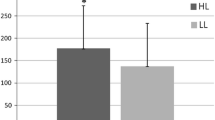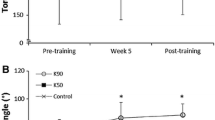Summary
The purpose of this investigation was to study the effect of one-legged exercise on the strength, power and endurance of the contralateral leg. The performance of the knee extensor and flexor muscle of 20 healthy young adults (10 men and 10 women) was first tested by Cybex II+ and 340 dynamometers. Then 10 subjects were chosen at random to train using one leg three times a week for 7 weeks whilst the other 10 served as controls. During the 8th week, the tests were repeated. Both quadriceps and hamstring muscles of the trained subjects showed a cross-transfer effect from the trained limb to the untrained side. This concerned the strength and power, as well as endurance characteristics of these muscles. The average change in peak torque of the quadriceps muscle was + 19% (P<0.001) in the trained limb, + 11% (P<0.01) in the untrained limb and 0% in the control limbs. In hamstring muscles the changes were + 14% (P<0.01), + 5% and −1%, respectively. Concerning muscle endurance (work performed during the last 5 contractions in the 25-repetition test) the corresponding changes were + 15% (P<0.01), +7% (P<0.01), and −1% in quadriceps muscle, and + 17% (P<0.05), +7%, and −3% in hamstring muscles. The average strength benefit in the untrained limb was +36% (hamstring muscles) and +58% (quadriceps muscle) of that achieved in the trained limb. Untrained hamstring muscle showed better benefits in the endurance parameters than in strength or power parameters, while in the quadriceps muscle this effect was reversed. A positive relationship was observed between the changes (greater improvement in the trained limb resulted in greater improvement in the untrained limb) (hamstring muscles:r=0.83,P<0.001, quadriceps muscle:r=0.53,P<0.001). In endurance parameters, this relationship was almost linear while in the strength and power parameters the results were more in favour of a curvilinear relationship with limited benefit.
Similar content being viewed by others
References
Brown MB, Forsythe AB (1974) Robust tests for the equality of variances. J Am Stat Assoc 69: 364–367
Burdett RG, van Swearingen J (1987) Reliability of isokinetic endurance tests. J Orthop Sports Phys Ther 8: 484–488
Coyle EF, Feiring DC, Rotkis TC, Cote RW III, Roby FB, Lee W, Wilmore JH (1981) Specificity of power improvements through slow and fast isokinetic training. J Appl Physiol 51: 1437–1442
Davies CTM, Sargeant AJ (1975) Effects of training on the physiological responses to one- and two leg work. J Appl Physiol 38: 377–381
Delitto A, Rose SJ, McKowen JM, Lehman RC, Thomas JA, Shively RA (1988) Electrical stimulation versus voluntary exercise in strengthening thigh musculature after anterior cruciate ligament surgery. Phys Ther 68: 660–663
Dixon WJ, Brown MB, Engelman L, Jennrich RI (eds) (1990) BMDP Statistical software manuals, vol. 1. University of California Press, Berkeley
Gerber C, Hoppeler H, Claassen H, Robotti G, Zehnder R, Jakob RP (1985) The lower-extremity musculature in chronic symptomatic instability of the anterior cruciate ligament. J Bone Joint Surg 67-A: 1034–1043
Gould N, Donnermayer D, Gammon GG, Pope M, Ashikaga T (1983) Transcutaneous muscle stimulation to retard disuse atrophy after open menisectomy. Clin Orthop 178: 190–197
Häggmark T, Eriksson E (1979) Cylinder or mobile cast brace after knee ligament surgery. Am J Sports Med 7: 48–56
Häkkinen K (1989) Neuromuscular and hormonal adaptation during strength and power training. A review. J Sports Med 29: 9–26
Hellebrandt FA, Parrish AM, Houtz SJ (1947) Cross education: the influence of unilateral exercise on the contralateral limb. Arch Phys Med 28: 76–85
Hodgkins J (1961) Influence of unilateral endurance training on contralateral limb. J Appl Physiol 16: 991–993
Ikai M, Steinhaus AH (1961) Some factors modifying the expression of human strength. J Appl Physiol 16: 157–163
Kannus P, Jarvinen M (1990) Nonoperative treatment of acute knee ligament injuries. A review with special reference to indications and methods. Sports Med 9: 244–260
Komi PV, Viitasalo JT, Rauramaa R, Vihko V (1978) Effect of isometric strength training on mechanical, electrical, and metabolic aspects of muscle function. Eur J Appl Physiol 40: 45–55
Krotkiewski M, Aniansson A, Grimby G, Björutorp P, Sjöström L (1979) The effect of unilateral isokinetic strength training on local adipose and muscle tissue morphology, thickness, and enzymes. Eur J Appl Physiol 42: 271–281
Kruse RD, Mathews DK (1958) Bilateral effects of unilateral exercise: experimental study based on 120 subjects. Arch Phys Med Rehabil 39: 371–376
Lapauttarakasem W (1988) Short term continuous passive motion. A feasibility study. J Bone Joint Surg 70-B: 802–806
Lewis S, Thompson P, Areskog NH, Vodak P, Marconyak M, DeBusk R, Mellen S, Haskell W (1980) Transfer effects of endurance training to exercise with untrained limbs. Eur J Appl Physiol 44: 25–34
Mathews DK, Shay CT, Godin F, Hodgon R (1956) Cross transfer effects of training on strength and endurance. Res Q 27: 206–212
Meyers CR (1967) Effects of two isometric routines on strength, size, and endurance in exercised and unexercised arms. Res Q 38: 430–440
Montgomery LC, Douglass LW, Deuster PA (1989) Reliability of an isokinetic test of muscle strength and endurance. J Orthop Sports Phys Ther 11: 315–322
Royston JP (1982) An extension of Shapiro and Wilk's W test for normality to large samples. Appl Stat 31: 115–124
Saltin B, Nazar K, Costill DL, Stein E, Jansson E, Essen B, Gollnick PD (1976) The nature of the training response; peripheral and central adaptations to one-legged exercise. Acta Physiol Scand 96: 289–305
Scripture EW, Smith TL, Brown EM (1894) On the education of muscular control and power. Stud Yale Psychol Lab 2: 114–119
Shaver LG (1970) Effects of training on relative muscular endurance in ipsilateral and contralateral arms. Med Sci Sports 2: 165–171
Steadman JR, Forster RS, Silfersskiold JP (1989) Rehabilitation of the knee. Clin Sports Med 8: 605–627
Tesch PA, Karlsson J (1984) Effects of exhaustive, isometric training on lactate accumulation in different muscle fiber types. Int J Sports Med 5: 89–91
Thigpen LK, Blanke D, Lang P (1990) The reliability of two different Cybex isokinetic systems. J Orthop Sports Phys Ther 12: 157–162
Veiersted KB (1991) The reproducibility of test contractions for calibration of electromyographic measurements. Eur J Appl Physiol 62: 91–98
Walter CE, Stewart CL, LeClaire JF (1960) Effect of short bouts of isometric and isotonic contractions on muscular strength and endurance. Am J Phys Med 39: 131–141
Wissler C, Richardson WW (1900) Diffusion of motor impulse. Psychol Rev 7: 29–38
Yasuda Y, Miyamura M (1983) Cross transfer effects of muscular training on blood flow in the ipsilateral and contralateral forearms. Eur J Appl Physiol 51: 321–329
Young A, Stokes M, Round JM, Edwards RHT (1983) The effect of high-resistance training on the strength and cross-sectional area of the human quadriceps. Eur J Clin Invest 13: 411–417
Author information
Authors and Affiliations
Rights and permissions
About this article
Cite this article
Kannus, P., Alosa, D., Cook, L. et al. Effect of one-legged exercise on the strength, power and endurance of the contralateral leg. Europ. J. Appl. Physiol. 64, 117–126 (1992). https://doi.org/10.1007/BF00717948
Accepted:
Issue Date:
DOI: https://doi.org/10.1007/BF00717948




